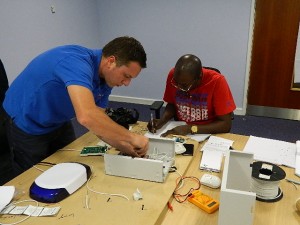How to use EOL wiring in alarm systems
Grades in alarm systems–
 Alarm systems are now categorized in different grades considering the risk or threat protected and the equipments in it to do so. Generally there are four grades named numerically from 1 to 4 with increasing risk factors. This grading is also used for the alarm and corresponding property protected through it. The property which can have armed and planned robbery and the corresponding alarm system would come in the 4th grade where it is considered the most serious and damaging with high security system as an insurance requirement also. Properties with lesser chances of burglaries are in third category and first category is where there is no necessity of insurance and the occurrence of burglary is a chance encounter.
Alarm systems are now categorized in different grades considering the risk or threat protected and the equipments in it to do so. Generally there are four grades named numerically from 1 to 4 with increasing risk factors. This grading is also used for the alarm and corresponding property protected through it. The property which can have armed and planned robbery and the corresponding alarm system would come in the 4th grade where it is considered the most serious and damaging with high security system as an insurance requirement also. Properties with lesser chances of burglaries are in third category and first category is where there is no necessity of insurance and the occurrence of burglary is a chance encounter.
Partially supervised loop–
With most of the grade 3 alarm installations there are provisions for change of resistance with intrusions. The events can altogether alter the resistance of the line and so can create an emergency situation and corresponding setting up of alarm. This can be done for the complete length of the wire or they can be for a selected portion where the threats are much greater. In most of these situations there are multiple alarms considering the pattern of resistance or intrusion. The partially supervised loop of wiring allows the control panel to monitor the wiring for certain area of operation or loop of the wire. This helps in detecting any short circuit or break in the in the line so that it can be sensed instantaneously.
Fully supervised loop-
In both fully supervised and partially supervised loop the measure of resistance is important. In fully supervised loop the line resistance is measured for all the length and the system supports this with immediate alarms when there is any break in the line. Since concealing the wiring can diminish the benefits associated with this wiring, this is suggested to remain open rather than concealed when installed. Any place where there is not enough facility to keep the line open it is better to avoid this wiring. Why do we need this type of alarm system or what are their benefits? Since this is recommended for grade 3 or above alarm systems which are very open to threats of burglary, the lines of wires are deliberately shorted to make the alarm inoperative or give false warning. The supervised systems allow us to avoid this situation. There can also be accidental situations to trigger the alarm of stop it from working.
Multiple detectors per zone-
Why do we need multiple resistors to sense the condition of the line? Just to fine tune the signal. This is in nutshell is the summary but consider that if a single resistor at end of line can give us the indication of open or closed line another will tell us why that happened. Whether a line is kept intentionally open or whether the circuit is truly broken or done intentionally by someone with intensions of threats, this is done mostly with each sensor positions by placing multiple resistors at ends of the resistors in parallel. These connections are in parallel to provide power to the sensing units even if the lines are broken.
Conclusion-
The utility of this system is debated by professionals but since this is recommended for grade 3 or about security systems the extra expense is worthwhile. To minimize cost one can go for the partially supervised loop which will safeguard the critical region and also cost less but to really have peace of mind one should go for the fully supervised loop detection loops.
